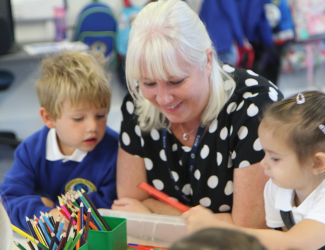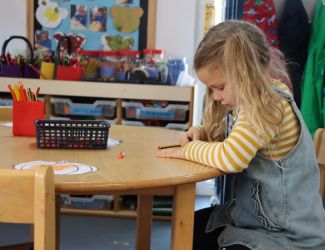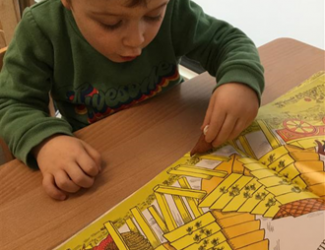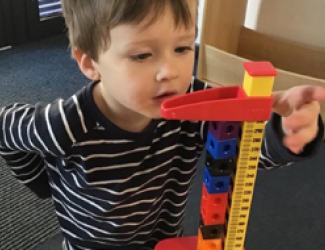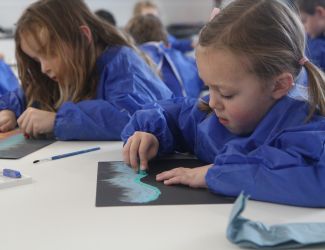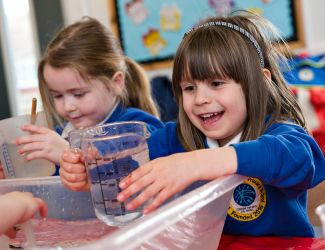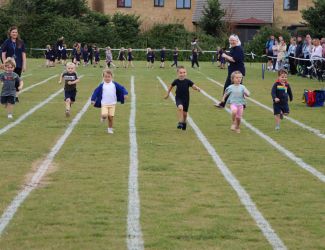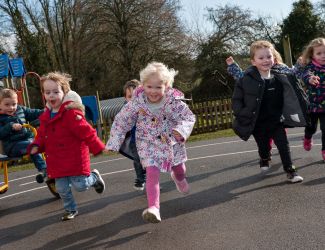Nursery Communication and Language Curriculum
Children will be taught...
EYFS Development Matters Statements Birth to Three
- Turn towards familiar sounds. They are also startled by loud noises and accurately locate the source of a familiar person’s voice, such as their key person or a parent.
- Gaze at faces, copying facial expressions and movements like sticking out their tongue. Make eye contact for longer periods.
- Watch someone’s face as they talk.
- Copy what adults do, taking ‘turns’ in conversations (through babbling) and activities. Try to copy adult speech and lip movements.
- Enjoy singing, music and toys that make sounds.
- Recognise and are calmed by a familiar and friendly voice.
- Listen and respond to a simple instruction.
- Make sounds to get attention in different ways (for example, crying when hungry or unhappy, making gurgling sounds, laughing, cooing or babbling).
- Babble, using sounds like ‘baba’, ‘mamama’.
- Use gestures like waving and pointing to communicate.
- Reach or point to something they want while making sounds.
- Copy your gestures and words.
- Constantly babble and use single words during play.
- Use intonation, pitch and changing volume when ‘talking’.
- Understand single words in context – ‘cup’, ‘milk’, ‘daddy’.
- Understand frequently used words such as ‘all gone’, ‘no’ and ‘bye-bye’.
- Understand simple instructions like “give to nanny” or “stop”.
- Recognise and point to objects if asked about them.
- Generally focus on an activity of their own choice and find it difficult to be directed by an adult.
- Listen to other people’s talk with interest, but can easily be distracted by other things.
- Make themselves understood, and can become frustrated when they cannot.
- Start to say how they are feeling, using words as well as actions.
- Start to develop conversation, often jumping from topic to topic.
- Develop pretend play: ‘putting the baby to sleep’ or ‘driving the car to the shops’.
- Use the speech sounds p, b, m, w.
- Pronounce:
- l/r/w/y
- f/th
- s/sh/ch/dz/j
- multi-syllabic words such as ‘banana’ and ‘computer’
- Listen to simple stories and understand what is happening, with the help of the pictures.
- Identify familiar objects and properties for practitioners when they are described. For example: ‘Katie’s coat’, ‘blue car’, ‘shiny apple’.
- Understand and act on longer sentences like ‘make teddy jump’ or ‘find your coat’.
- Understand simple questions about ‘who’, ‘what’ and ‘where’ (but generally not ‘why’).
EYFS Development Matters Statements Three to Four Year Olds
- Enjoy listening to longer stories and can remember much of what happens.
- Pay attention to more than one thing at a time, which can be difficult.
- Use a wider range of vocabulary.
- Understand a question or instruction that has two parts, such as “Get your coat and wait at the door”.
- Understand ‘why’ questions, like: “Why do you think the caterpillar got so fat?”
- Sing a large repertoire of songs.
- Know many rhymes, be able to talk about familiar books, and be able to tell a long story.
- Develop their communication, but may continue to have problems with irregular tenses and plurals, such as ‘runned’ for ‘ran’, ‘swimmed’ for ‘swam’.
- Develop their pronunciation but may have problems saying:
- Some sounds: r, j, th, ch, and sh
- Multisyllabic words such as ‘pterodactyl’, ‘planetarium’ or ‘hippopotamus’
- Use longer sentences of four to six words.
- Be able to express a point of view and to debate when they disagree with an adult or a friend, using words as well as actions.
- Start a conversation with an adult or a friend and continue it for many turns.
- Use talk to organise themselves and their play: “Let’s go on a bus... you sit there... I’ll be the driver.”

